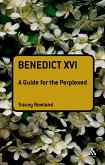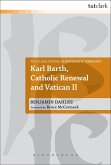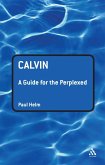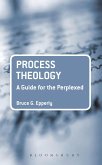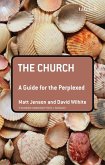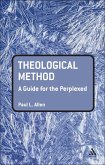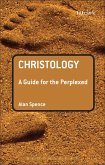Rodney Howsare
Balthasar: A Guide for the Perplexed (eBook, PDF)
20,95 €
20,95 €
inkl. MwSt.
Sofort per Download lieferbar

10 °P sammeln
20,95 €
Als Download kaufen

20,95 €
inkl. MwSt.
Sofort per Download lieferbar

10 °P sammeln
Jetzt verschenken
Alle Infos zum eBook verschenken
20,95 €
inkl. MwSt.
Sofort per Download lieferbar
Alle Infos zum eBook verschenken

10 °P sammeln
Rodney Howsare
Balthasar: A Guide for the Perplexed (eBook, PDF)
- Format: PDF
- Merkliste
- Auf die Merkliste
- Bewerten Bewerten
- Teilen
- Produkt teilen
- Produkterinnerung
- Produkterinnerung

Bitte loggen Sie sich zunächst in Ihr Kundenkonto ein oder registrieren Sie sich bei
bücher.de, um das eBook-Abo tolino select nutzen zu können.
Hier können Sie sich einloggen
Hier können Sie sich einloggen
Sie sind bereits eingeloggt. Klicken Sie auf 2. tolino select Abo, um fortzufahren.

Bitte loggen Sie sich zunächst in Ihr Kundenkonto ein oder registrieren Sie sich bei bücher.de, um das eBook-Abo tolino select nutzen zu können.
In Balthasar: A Guide for the Perplexed, Rodney Howsare gives the reader a handle on these perplexing aspects of Balthasar's thought. In the first chapter he introduces the reader to the man and his unique method of doing theology. He then moves on to explaining the basic structure and nature of Balthasar's trilogy: the aesthetics, dramatics, and logic. He then deals with various theological topics: Jesus Christ, The Trinity, The Drama of Redemption, The Church and Mary, and The Last Things. A final chapter summarizes Balthasar's place in modern theology and suggests further readings for the interested reader.…mehr
- Geräte: PC
- mit Kopierschutz
- eBook Hilfe
- Größe: 0.82MB
Andere Kunden interessierten sich auch für
![Benedict XVI: A Guide for the Perplexed (eBook, PDF) Benedict XVI: A Guide for the Perplexed (eBook, PDF)]() Tracey RowlandBenedict XVI: A Guide for the Perplexed (eBook, PDF)20,95 €
Tracey RowlandBenedict XVI: A Guide for the Perplexed (eBook, PDF)20,95 €![Karl Barth, Catholic Renewal and Vatican II (eBook, PDF) Karl Barth, Catholic Renewal and Vatican II (eBook, PDF)]() Benjamin DahlkeKarl Barth, Catholic Renewal and Vatican II (eBook, PDF)31,95 €
Benjamin DahlkeKarl Barth, Catholic Renewal and Vatican II (eBook, PDF)31,95 €![Calvin: A Guide for the Perplexed (eBook, PDF) Calvin: A Guide for the Perplexed (eBook, PDF)]() Paul HelmCalvin: A Guide for the Perplexed (eBook, PDF)20,95 €
Paul HelmCalvin: A Guide for the Perplexed (eBook, PDF)20,95 €![Process Theology: A Guide for the Perplexed (eBook, PDF) Process Theology: A Guide for the Perplexed (eBook, PDF)]() Bruce G. EpperlyProcess Theology: A Guide for the Perplexed (eBook, PDF)20,95 €
Bruce G. EpperlyProcess Theology: A Guide for the Perplexed (eBook, PDF)20,95 €![The Church: A Guide for the Perplexed (eBook, PDF) The Church: A Guide for the Perplexed (eBook, PDF)]() Matt JensonThe Church: A Guide for the Perplexed (eBook, PDF)20,95 €
Matt JensonThe Church: A Guide for the Perplexed (eBook, PDF)20,95 €![Theological Method: A Guide for the Perplexed (eBook, PDF) Theological Method: A Guide for the Perplexed (eBook, PDF)]() Paul L. AllenTheological Method: A Guide for the Perplexed (eBook, PDF)20,95 €
Paul L. AllenTheological Method: A Guide for the Perplexed (eBook, PDF)20,95 €![Christology: A Guide for the Perplexed (eBook, PDF) Christology: A Guide for the Perplexed (eBook, PDF)]() Alan J. SpenceChristology: A Guide for the Perplexed (eBook, PDF)21,95 €
Alan J. SpenceChristology: A Guide for the Perplexed (eBook, PDF)21,95 €-
-
-
In Balthasar: A Guide for the Perplexed, Rodney Howsare gives the reader a handle on these perplexing aspects of Balthasar's thought. In the first chapter he introduces the reader to the man and his unique method of doing theology. He then moves on to explaining the basic structure and nature of Balthasar's trilogy: the aesthetics, dramatics, and logic. He then deals with various theological topics: Jesus Christ, The Trinity, The Drama of Redemption, The Church and Mary, and The Last Things. A final chapter summarizes Balthasar's place in modern theology and suggests further readings for the interested reader.
Produktdetails
- Produktdetails
- Verlag: Bloomsbury eBooks UK
- Seitenzahl: 200
- Erscheinungstermin: 30. Juni 2009
- Englisch
- ISBN-13: 9780567101044
- Artikelnr.: 38222794
- Verlag: Bloomsbury eBooks UK
- Seitenzahl: 200
- Erscheinungstermin: 30. Juni 2009
- Englisch
- ISBN-13: 9780567101044
- Artikelnr.: 38222794
- Herstellerkennzeichnung Die Herstellerinformationen sind derzeit nicht verfügbar.
Rodney A. Howsare is Associate Professor of Fundamental Theology, DeSales University, Center Valley, Pennsylvania, USA.
Contents
Introduction
Chapter One: Balthasar: The Man and his Place in 20th Century Theology
I. Biographical Sketch: The Early Years
II. Biographical Sketch: Important Influences
A. Erich Przywara
B. Henri de Lubac
C. Adrienne von Speyr
D. Karl Barth
III. Conclusion: The Last Years
Chapter Two: Balthasar's Method: Background and History I. The Problem of
Theological Method
II. The History of Theology: Fathers, Scholastics and Ourselves
A. The Cosmocentric Method: the Fathers
B. Scholasticism, Thomas Aquinas and the Real Distinction C. The
Anthropocentric Turn
III. Concluding Remarks
Chapter Three: Balthasar's Theological Style
I. The Meaning and Purpose of Meta-Anthropology
II. The Role of Philosophy
III. The Concretization of the Philosophical Act: The Fourfold Distinction
IV. Four Notes on Balthasar's Christocentrism
V. Preliminary Summary
VI. The Trilogy and the Transcendentals
A. Aesthetics: The Glory of the Lord
B. Dramatics: Theo-Drama
C. Logic: Theo-Logic
Chapter Four: Jesus Christ and the Meaning of Scripture
I. Theological Aesthetics and the Study of the Bible
II. Theological Aesthetics and New Testament Christology III. Concluding
Remarks
Chapter Five: Jesus Christ and the Drama of Finite and Infinite Freedom
I. The Drama of Finite and Infinite Freedom
II. Theo-Dramatic Christology
A. Preliminary Considerations
B. The New Testament and Christology
1. The Jesus of History and the Christ of Faith
2. Jesus' Imminent Expectation of the End
3. Pro Nobis
III. Preliminary Conclusions
Chapter Six: The Trinity and the Cross
I. Introduction: Bringing it all Back Home
II. Jesus Christ: His Person, Nature and Mission
A. Balthasar's Starting Point: The Mission of Jesus
B. The Person and Nature of Jesus in the Light of his Mission C. Some
Preliminary Conclusions: The Implications of the Word
III. The Trinity and the Cross
IV. Conclusion
Chapter Seven: Balthasar's Ongoing Role in Theology
I. Summary and Conclusion
II. Balthasar's Place in Theology Today
A. Balthasar and Postliberalism
B. Balthasar and Radical Orthodoxy
C. Balthasar and the Resurgence of Traditionalist Catholicism
Introduction
Chapter One: Balthasar: The Man and his Place in 20th Century Theology
I. Biographical Sketch: The Early Years
II. Biographical Sketch: Important Influences
A. Erich Przywara
B. Henri de Lubac
C. Adrienne von Speyr
D. Karl Barth
III. Conclusion: The Last Years
Chapter Two: Balthasar's Method: Background and History I. The Problem of
Theological Method
II. The History of Theology: Fathers, Scholastics and Ourselves
A. The Cosmocentric Method: the Fathers
B. Scholasticism, Thomas Aquinas and the Real Distinction C. The
Anthropocentric Turn
III. Concluding Remarks
Chapter Three: Balthasar's Theological Style
I. The Meaning and Purpose of Meta-Anthropology
II. The Role of Philosophy
III. The Concretization of the Philosophical Act: The Fourfold Distinction
IV. Four Notes on Balthasar's Christocentrism
V. Preliminary Summary
VI. The Trilogy and the Transcendentals
A. Aesthetics: The Glory of the Lord
B. Dramatics: Theo-Drama
C. Logic: Theo-Logic
Chapter Four: Jesus Christ and the Meaning of Scripture
I. Theological Aesthetics and the Study of the Bible
II. Theological Aesthetics and New Testament Christology III. Concluding
Remarks
Chapter Five: Jesus Christ and the Drama of Finite and Infinite Freedom
I. The Drama of Finite and Infinite Freedom
II. Theo-Dramatic Christology
A. Preliminary Considerations
B. The New Testament and Christology
1. The Jesus of History and the Christ of Faith
2. Jesus' Imminent Expectation of the End
3. Pro Nobis
III. Preliminary Conclusions
Chapter Six: The Trinity and the Cross
I. Introduction: Bringing it all Back Home
II. Jesus Christ: His Person, Nature and Mission
A. Balthasar's Starting Point: The Mission of Jesus
B. The Person and Nature of Jesus in the Light of his Mission C. Some
Preliminary Conclusions: The Implications of the Word
III. The Trinity and the Cross
IV. Conclusion
Chapter Seven: Balthasar's Ongoing Role in Theology
I. Summary and Conclusion
II. Balthasar's Place in Theology Today
A. Balthasar and Postliberalism
B. Balthasar and Radical Orthodoxy
C. Balthasar and the Resurgence of Traditionalist Catholicism
Contents
Introduction
Chapter One: Balthasar: The Man and his Place in 20th Century Theology
I. Biographical Sketch: The Early Years
II. Biographical Sketch: Important Influences
A. Erich Przywara
B. Henri de Lubac
C. Adrienne von Speyr
D. Karl Barth
III. Conclusion: The Last Years
Chapter Two: Balthasar's Method: Background and History I. The Problem of
Theological Method
II. The History of Theology: Fathers, Scholastics and Ourselves
A. The Cosmocentric Method: the Fathers
B. Scholasticism, Thomas Aquinas and the Real Distinction C. The
Anthropocentric Turn
III. Concluding Remarks
Chapter Three: Balthasar's Theological Style
I. The Meaning and Purpose of Meta-Anthropology
II. The Role of Philosophy
III. The Concretization of the Philosophical Act: The Fourfold Distinction
IV. Four Notes on Balthasar's Christocentrism
V. Preliminary Summary
VI. The Trilogy and the Transcendentals
A. Aesthetics: The Glory of the Lord
B. Dramatics: Theo-Drama
C. Logic: Theo-Logic
Chapter Four: Jesus Christ and the Meaning of Scripture
I. Theological Aesthetics and the Study of the Bible
II. Theological Aesthetics and New Testament Christology III. Concluding
Remarks
Chapter Five: Jesus Christ and the Drama of Finite and Infinite Freedom
I. The Drama of Finite and Infinite Freedom
II. Theo-Dramatic Christology
A. Preliminary Considerations
B. The New Testament and Christology
1. The Jesus of History and the Christ of Faith
2. Jesus' Imminent Expectation of the End
3. Pro Nobis
III. Preliminary Conclusions
Chapter Six: The Trinity and the Cross
I. Introduction: Bringing it all Back Home
II. Jesus Christ: His Person, Nature and Mission
A. Balthasar's Starting Point: The Mission of Jesus
B. The Person and Nature of Jesus in the Light of his Mission C. Some
Preliminary Conclusions: The Implications of the Word
III. The Trinity and the Cross
IV. Conclusion
Chapter Seven: Balthasar's Ongoing Role in Theology
I. Summary and Conclusion
II. Balthasar's Place in Theology Today
A. Balthasar and Postliberalism
B. Balthasar and Radical Orthodoxy
C. Balthasar and the Resurgence of Traditionalist Catholicism
Introduction
Chapter One: Balthasar: The Man and his Place in 20th Century Theology
I. Biographical Sketch: The Early Years
II. Biographical Sketch: Important Influences
A. Erich Przywara
B. Henri de Lubac
C. Adrienne von Speyr
D. Karl Barth
III. Conclusion: The Last Years
Chapter Two: Balthasar's Method: Background and History I. The Problem of
Theological Method
II. The History of Theology: Fathers, Scholastics and Ourselves
A. The Cosmocentric Method: the Fathers
B. Scholasticism, Thomas Aquinas and the Real Distinction C. The
Anthropocentric Turn
III. Concluding Remarks
Chapter Three: Balthasar's Theological Style
I. The Meaning and Purpose of Meta-Anthropology
II. The Role of Philosophy
III. The Concretization of the Philosophical Act: The Fourfold Distinction
IV. Four Notes on Balthasar's Christocentrism
V. Preliminary Summary
VI. The Trilogy and the Transcendentals
A. Aesthetics: The Glory of the Lord
B. Dramatics: Theo-Drama
C. Logic: Theo-Logic
Chapter Four: Jesus Christ and the Meaning of Scripture
I. Theological Aesthetics and the Study of the Bible
II. Theological Aesthetics and New Testament Christology III. Concluding
Remarks
Chapter Five: Jesus Christ and the Drama of Finite and Infinite Freedom
I. The Drama of Finite and Infinite Freedom
II. Theo-Dramatic Christology
A. Preliminary Considerations
B. The New Testament and Christology
1. The Jesus of History and the Christ of Faith
2. Jesus' Imminent Expectation of the End
3. Pro Nobis
III. Preliminary Conclusions
Chapter Six: The Trinity and the Cross
I. Introduction: Bringing it all Back Home
II. Jesus Christ: His Person, Nature and Mission
A. Balthasar's Starting Point: The Mission of Jesus
B. The Person and Nature of Jesus in the Light of his Mission C. Some
Preliminary Conclusions: The Implications of the Word
III. The Trinity and the Cross
IV. Conclusion
Chapter Seven: Balthasar's Ongoing Role in Theology
I. Summary and Conclusion
II. Balthasar's Place in Theology Today
A. Balthasar and Postliberalism
B. Balthasar and Radical Orthodoxy
C. Balthasar and the Resurgence of Traditionalist Catholicism

